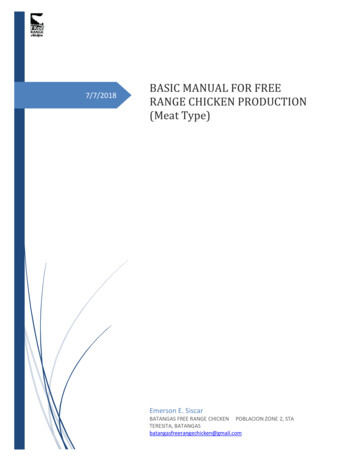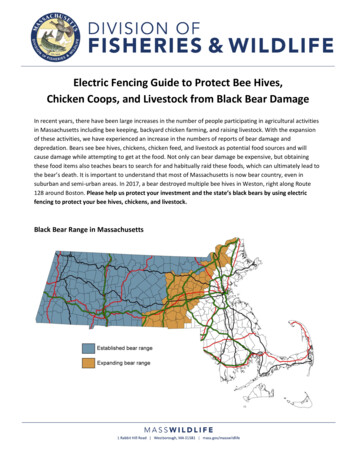
Transcription
15th International Conference on Environmental Science and TechnologyRhodes, Greece, 31 August to 2 September 2017Effect of Chicken Feather and Boron Compounds as Filler onMechanical and Flame Retardancy Properties of PolymerComposite MaterialsGokdai D.1, Akpinar Borazan A .1,* And Guru M.21Bilecik Seyh Edebali University, Chemical and Process Engineering Department, 11210, Bilecik2Gazi University, Chemical Engineering Department, 06570, Ankara*corresponding author:e-mail: alev.akpinar@bilecik.edu.trAbstract Sustainable utilization of solid waste has beeninfluenced by increasing population of the world. Benefitsof using solid waste based on natural fiber in polymermaterial are biodegradability and cost effectiveness. Inpoultry farms, chicken poultry, one of the slaughterhousewastes, is confronted as 30 thousand tons of waste per yearin Turkey. The evaluation of this waste, which is quite richin keratin, is extremely important both for the solution ofthe waste problem and for bringing this valuable materialto the economy. These fibers are stable, durable andbiodegradable because they have a crystalline structure.However, this valuable waste will have a positive effectwhen used together with boron minerals which bothincrease the mechanical properties, flame retardancy andbiodegradation of composite material. The aim of thisstudy is to manufacture superior polyester-based compositematerials reinforced with three kinds of boron mineralssuch as; boron oxide, borax pentahydrate, boraxdecahydrate and fibers recycled from waste chickenfeathers. The effect of different filling ratios of fillingmaterials on the mechanical and physical properties ofcomposite materials was examined. Flame retardancyproperties of the composites with best mechanical resultswere investigated. After pouring by means of the precasting process, the water absorption and swellingthickness of final products, as well as density, bendingstrength, flexural modulus, limiting oxygen index (LOI),TGA (Thermogravimetric Analysis) and SEM analysis,was performed. Mixing prescriptions and conditions withthe best properties were determined. According tomechanical, physical and flame retardancy analysis it canbe concluded that chicken feather and boron compoundshave a good synergic effect when used together incomposite material instead of using boron compounds/chicken feather alone.Keywords: Polymer matrix composites, boron, wastechicken feather, flame retardancy, mechanical properties1.IntroductionProducts of various animal sources are generally used foruseful purposes. Studies about short fiber compositesbased on agricultural waste have increased more recently.These fibers are generally more environmentally friendlyand relatively easier to obtain at lower densities thaninorganic fibers (Barone and Schmidth, 2004). Besidethese superior properties flame retardant of composites arealso important in order to provide safety necessity of theproducts. Fire retardants are chemicals that increase thetemperature to above normal and literally increase theignition point of the materials. This limit varies as afunction of the retarder, but in any case it tries to reducethe risk of fire (Oliwa et al., 2016). Recently, biochar,wool, calcium carbonate with diammonium phospate etc.was used to bring a flame retardant property to thecomposite material (Das et al., 2017; Das et al., 2016;Suharty et al., 2012). The effect of zinc borate, boric acidand boric oxide on flammability of epoxy resin containingred phosphorus was investigated by Doğan and Unlu.According to the LOI values and thermal gravimetricanalysis (TGA) results the boron compounds showed agood effect by increasing char yield in the condensedphase (Doğan and Unlu, 2014). Yhang et al. also provedthat contribution of boron to epoxy composites wassuccessful to form swollen and glassy char layers withbarrier effect on providing free radicals (Yang et al.,2016). Beside flame retardancy of composites there arealso several studies on mechanical properties ofcomposites reinforced with chicken feather. In the study ofBarone and Schmidt mechanical properties of polyethylenereinforced with chicken feathers were obtained. The resultsshow that improvement of a polymer matrix can beprovided with keratin feather fiber. According to theirmechanical analysis there is an observed increase inflexural modulus when the keratin feather fiber loadingincreased (Barone and Schmidth, 2005). Cheng et al. alsoconcluded in their study chicken feathers had a positiveeffect on mechanical properties of composites. They usedpoly lactic acid as a polymer matrix and chicken featherfiber (CFF) as filler. Due to the CFF reinforcement theflexural modulus of CFF/PLA composites weresignificantly higher than that of pure PLA (Cheng et al.,2009).In literature studies about investigation of the flammabilityof composites reinforced with chicken feather and boronminerals have not been researched yet. In this study unlikethe literature synergic effect of chicken feather and boronminerals on polymer composite materials was investigated.CEST2017 01281
2.Table 1. Ratio of materials used for compositemanufactureMaterials and Method2.1. MaterialsIn this study composite materials were produced frompolyester resin (Polipol 383-G, Poliya Composite Resinsand Polymers Inc., density of 1.076 0.05 g/cm3 as astandard ISO 1675), waste chicken feather obtained from apoultry in Turkey and three kinds of boron mineralssupplied by Eti Maden in Turkey. Boron oxide (density of1.84 g/cm3, particle size 0.315 mm), borax decahydrate(density of 1.71 g/cm3, particle size 1.180 mm), boraxpentahydrate (density of 1.81 g/cm3, particle size 1.180mm) and chicken feather were used as reinforcement.Methyl ethyl ketone peroxide was hardener (MEKP)(Butanox M-60, AkzoNobel Products) and Cobalt 1%solution was promoters used in the curing of polyesterresins. Polypropylene graft maleic anhydride (AldrichChemistry) was used as a coupling agent. In Fig. 1 imagesof reinforcements can be seen.[V %]: Volume percentF: Chicken featherB1: boron oxideB2: borax pentahydrateB3: borax decahydratePolyester resin and reinforcement materials were firstmixed in the indicated ratios using a speed of 700, 1200and 1700 rpm (Stuart scientific mechanical stirrer), 5minutes cycle time for each. Mixture was hold on underthe vacuum in 5 min. After the accelerator and hardenerwere added to mixture last mixture was poured into amold. Composites which were in the mold for 2 hours werekept at room temperature for 1 day and then kept at 110 Cfor 2 hours in an oven (Binder, Germany).2.4.Figure 1. Images of reinforcements, a1) Waste chickenfeathers a2) waste chicken feather powder b1) boron oxideb2) borax decahydrate, b3) borax pentahydrate2.2. Pretreatment of chicken feathersA pre-treatment was required to stabilize and transformchicken feathers into a stable technical material. Firstlychicken feathers were washed with water. Afterward, quillwas separated from barbs and cut into small pieces. Finallylast drying was again in oven at 105 C, for 2 hours.Moisture of clean feather fibers was decreased to 10%.The boron minerals which have more than 10% moisturewere dried in a drying oven at 40 C to provide moistureless than 10%. Finally waste chicken feathers were groundrespectively in a precision grinder (Fritsch- Pulverisette9,GmbH) equipped with sieve (Fritsch, Analysette 3).2.3.Composite preparationThe polyester matrix was compounded, respectively, withreinforcement fillings in different ratios by volume. Theraw material formulations, which are given per the volumeproportion in percentage, used for the composites arepresented in Table 1.Experimental MethodThree point bending tests were carried out at a bendingspeed of 2 mm/min in Shimadzu AG-IC Test Machine todetermine the mechanical properties of composites.Following formulas were used for calculations of the threepoint bending tests. The 5 samples of each group weretested and average values were reported. The bendingmeasurements were performed at the ambient conditions(23 2 C).Density measurements of the composite specimens weredone according to the Archimedes’ Principle. The physicalproperties examined were bulk density, thickness swelling(TS), open porosity and water absorption (WA). Thesetests were carried out with test sample sizes of 5x5 cm.Following formulas were used to obtain physical propertiesof composite materials.Bulk density (W1/(W3-W2))*ρwater(2.1)% Open porosity ((W3-W1)/(W3-W2))*100(2.2)% WA (W3 -W1 ) / W1 * 100(2.3)W1; dry weightW2 ;suspended weightW3; wet weightThe flame retardancy properties of composite materialswere carried out according to ASTM D 2863 standard.CEST2017 01281
(Dynisco Polymer Test LOI Limiting Oxygen IndexChamber) This standard covers the methods used todetermine the minimum oxygen concentration required tobe present in nitrogen-oxygen mixtures for thecontinuation of the flushes of the test specimens in theupright position under certain test conditions. In principle,a small test sample is placed vertically into a transparentchimney passing through a mixture of oxygen and nitrogenup through it. The top of the test sample is ignited,followed by the burning behavior of the test sample, andthe duration of the burn or the duration of the burning testsample is compared to predetermined threshold values forsuch combustion. Experiments using a series of testsamples at different oxygen concentrations predict thesmallest oxygen concentration value required forcontinuation of the burn (Ayar et al., 2014). The results aregiven in terms of the oxygen index value (ASTM D286313).Thermal properties of the composite samples were carriedout by using Seteram LabSys Evo analyzer. 5–9 mg ofmeasured composite was kept in alumina crucible undernitrogen atmosphere with a flow rate of 20 ml/min byraising its temperature from 20 C to 800 C in steps of 20 C/min.3. Results and Discussions3.1. Mechanical Properties of CompositesFigure 2 shows the flexural strength value of boron/polyester composites. If we compare three kinds of boronminerals it can be indicated that boron oxide has higherstrength.This is because of the anhydrous structure of boron oxidewhile the other compounds consist water molecules in theirformulas (B2; borax pentahydrate, Na2B4O7. 5H2O, B3;borax decahydrate, Na2B4O7. 10H2O). Water molecules ledto microvoids at the interface between the polymer andfibers these voids cause a decrease in mechanicalproperties. (Arrakhiz et al., 2013). Figure 3 shows theeffect of chicken feather filler on mechanical properties ofcomposites. Bending properties of each chickenfeather/boron compounds were investigated. When graphswere evaluated it can be clearly seen that chicken featherfiller only improved the boron oxide strength. The otherboron compounds (B2 and B3) with chicken feathercomposites have not strength values as much as FFB1composite series. The highest value of flexural modulusbelongs to chicken feather/polyester composites is nearly3600 MPa. We can exactly see from figure 3 all kind ofboron doped chicken feather composites have higherflexural modulus values. It can be concluded thatespecially boron oxide improved the composite resistanceto being deformed elastically.Figure 2. Bending properties of boron/polyestercompositesFigure 3. Bending properties of waste chicken featherpowder/boron compounds polyester compositesAmong the composites B3P has the highest waterabsorption value. It was thought because of the highamount of water molecules in borax decahydrate. We canconclude that water absorption values show compliancewith swelling thickness and open porosity values. Whilethe composites swelling and open porosities in compositestructure increased their capability of water absorptionincreased. For all composites bulk density valuesdecreased with the increasing amount of fillers.3.3 Flame Retardancy Properties of CompositesFlame retardancy properties of composites which give thebest mechanical properties were obtained according toASTM D 2863 standard. LOI values of three samples withbetter mechanical and physical properties (B1P, FF3P andFF3B1P) were given in Table 3 and images of burnedsamples were given in Figure 4. It is known that if thecomposite sample has higher LOI value it means it hasmore stable behavior in flame and duration to burn itcompletely is longer. From Table 3 and Figure 4 it can beobserved that polyester composites reinforced with boronoxide and chicken feather have higher LOI values than theothers.Table 2. Physical properties of composite materials3.2. Physical Properties of CompositesTable 2 shows the physical properties of compositematerials such as bulk density, open porosity, thicknessswelling and water absorption.CEST2017 01281
Table 3. Flame retardancy properties of compositematerialsBoron oxide can be used as a flame retardant in manymanufacturing process. From these results it can beconcluded that boron oxide improved the flame retardancyof polyester composites with a gain of approximately 26%.3.4. TGA Analysis of CompositesThermal stability results of composite samples which wereexposed to LOI test were given by TG, DTG and DTAanalysis in Figure 5. The top curve refers TG, the bottomcurve refers DTA and the middle one mentions the DTGcurve of composite samples.According to results it can be indicated when boron oxidefiller was used with chicken feather the residual mass valueincreased to 20.67 % from 8.74 %. It is also compatiblewith the LOI test results as boron oxide gives a flamereterdancy to composites. B2O3 is known as hard glass andthe crystal structure begin to deteriorate at 300 C, and aseries of suboxides are produced by partial melting untilfull fusion is reached at 700 C. As boron oxide isanhydrous it can behave as blowing agent which provide a“glue” to keep the combustion char and provide structuralunity to the char (Jimenez et al., 2006).Figure 4. Composite samples measured for LOI testFigure 5. TG, DTG and DTA curv
(Dynisco Polymer Test LOI Limiting Oxygen Index Chamber) This standard covers the methods used to determine the minimum oxygen concentration required to be present in nitrogen-oxygen mixtures for the continuation of the flushes of the test specimens in the upright position under certain test conditions. In principle, a small test sample is placed vertically into a transparent chimney passing .




